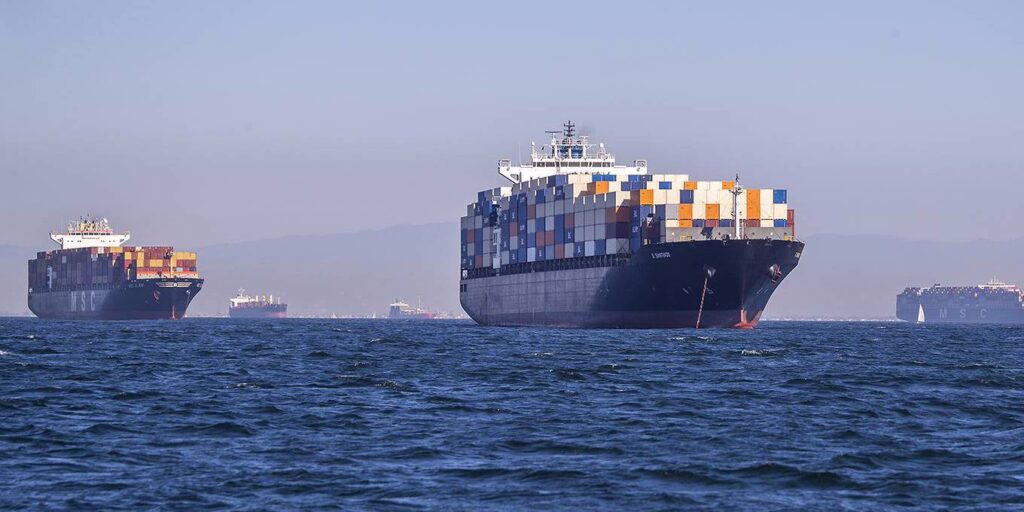The Choking of the Global Minotaur
ANGLO AMERICA, 22 Nov 2021
James K. Galbraith | Popular Resistance – TRANSCEND Media Service
21 Nov 2021 – The supply disruptions plaguing the US economy are not the result of “excessive demand,” “central planning,” or a lack of efficiency. Rather, it is that a logistics ecosystem that was developed to feed the beast of American consumption was not designed for a pandemic.
11 Nov 2021 – A supply chain is like a Rorschach Test: each economic analyst sees in it a pattern reflecting his or her own preconceptions. This may be inevitable, since everyone is a product of differing educations, backgrounds, and prejudices. But some observed patterns are more plausible than others.
Consider the following sampling of perspectives. For Jason Furman, formerly US President Barack Obama’s chief economic adviser, and Lawrence H. Summers, a former US secretary of the treasury, today’s supply-chain problem is one of excessive demand. According to Furman, it is a “high class” issue that reflects a strong economy. The “original sin” was the American Rescue Plan, which provided too much support through funds disbursed directly to US households.
For John Tamny of RealClearMarkets, the supply-chain problem is one of “central planning.” Had President Joe Biden’s administration not sent directives to port managers, free markets would have sorted everything out. And for Awi Federgruen, a professor of management at the Columbia Business School, the issue is inefficiency, the remedy for which is to work harder and do more with less.
None of these interpretations withstands scrutiny. The excess demand story fails on a glance. After all, there is no shortage of goods. Ships bearing the supply – 30 million tons of it – are sitting right now outside US ports, with more on the way. Nor have production prices risen by much. Most of the “inflation” so far has been in energy (driven partly by a rebound from the pandemic slump) and in used cars and trucks, previously produced goods that are in demand because of the semiconductor shortage affecting automakers.
And no, that particular shortage is not the result of “excess demand,” either. During the pandemic, chipmakers predicted a bigger shift in the composition of demand – toward household gizmos and away from cars – than actually occurred. Now they have too much of one kind of chip and not enough of another. As for the “central planning” jibe, that is to be expected from certain circles. The implication is that all would be well if only the Biden administration had not been paying attention. Never mind that the extent of Biden’s intervention was merely to urge port managers to work “24/7” to get the boats unloaded – an idea that one assumes would have already crossed their minds.
The point about “efficiency” gets closer to reality, except that the problem is not too little efficiency, but too much. To be precise, the extreme efficiency of today’s global supply chains is also their fatal flaw. Well-run ports are models of high throughput and low costs. They incorporate docks, railheads, truck bays, storage areas, and heavy-lifting equipment to suit the traffic they expect. Building capacity beyond a small margin of safety would be a waste.
In normal times, any excess capacity sits idle, yielding no revenue while interest on the debt issued to build it still must be paid. Over time, efficient operators will minimize the excess and keep the docks and machinery they have humming away. The spectacular success of global supply chains – up until now – reflects the relentless operation of this principle.
In the pandemic slump, much of America’s port capacity was briefly idle. When production stopped and container ships remained anchored in Asian ports, American trucks left their own empty containers to pile up at the ports, awaiting ships to carry them back to Asia. But then demand revived and production restarted – even accelerated – as households diverted income from services to goods. The ships bearing the goods started showing up again. But there was a new problem: to offload full containers, one must have a place to put them. According to press reports, the yards and warehouses were already filled with empties. Moreover, trucks bearing fresh empties could not unload them, and thus could not take on new containers.
And so, the cargoes sit and wait. Partial solutions – stacking the empties higher, for example – can go only so far. Over a longer period, new docks and rail lines can be built. But all of that takes time, land (which is not easy to find, it turns out), and heavy equipment, which itself must come from somewhere, possibly by ship.
A supply chain is an entire ecology, a biophysical entity. It requires all of its parts to function smoothly all of the time. Failures are not isolated to one segment, nor can they be fixed with a simple increase in prices or fees, or by some rapid change in techniques. Instead, they cascade through a system that was built in a specific way; a breakdown in one part can become a general one.
In his remarkable 2011 book, The Global Minotaur, the economist (and future Greek finance minister) Yanis Varoufakis compared the United States to the mythical monster that lived in a labyrinth from which nothing that entered could escape. For 40 years, the US economy has taken in the consumption goods produced by Japan, South Korea, China, and others. To sustain the insatiable Minotaur, the world built a global labyrinth of ports, ships, more ports, warehouses, storage yards, roads, and rails.
Then, one day, the Minotaur got sick and missed a meal. The next day, he sought to catch up by eating four meals, only to find that his gullet was not quite wide enough to get them all down. So, now the Minotaur sits, choking and helpless, hoping the blockage will clear. If it doesn’t, the consequences could be grave. If choking the beast in this way had occurred to Theseus, he might not have needed Ariadne, her sword, or her ball of yarn.
______________________________________________
 James K. Galbraith, Professor of Government and Chair in Government/Business Relations at the University of Texas at Austin, is a former staff economist for the House Banking Committee and a former executive director of the Joint Economic Committee of Congress. From 1993-97, he served as chief technical adviser for macroeconomic reform to China’s State Planning Commission. He is the author of Inequality: What Everyone Needs to Know and Welcome to the Poisoned Chalice: The Destruction of Greece and the Future of Europe. Email: Galbraith@mail.utexas.edu
James K. Galbraith, Professor of Government and Chair in Government/Business Relations at the University of Texas at Austin, is a former staff economist for the House Banking Committee and a former executive director of the Joint Economic Committee of Congress. From 1993-97, he served as chief technical adviser for macroeconomic reform to China’s State Planning Commission. He is the author of Inequality: What Everyone Needs to Know and Welcome to the Poisoned Chalice: The Destruction of Greece and the Future of Europe. Email: Galbraith@mail.utexas.edu
Go to Original – popularresistance.org
Tags: Anglo America, Capitalism, Economics, Trade, USA
DISCLAIMER: The statements, views and opinions expressed in pieces republished here are solely those of the authors and do not necessarily represent those of TMS. In accordance with title 17 U.S.C. section 107, this material is distributed without profit to those who have expressed a prior interest in receiving the included information for research and educational purposes. TMS has no affiliation whatsoever with the originator of this article nor is TMS endorsed or sponsored by the originator. “GO TO ORIGINAL” links are provided as a convenience to our readers and allow for verification of authenticity. However, as originating pages are often updated by their originating host sites, the versions posted may not match the versions our readers view when clicking the “GO TO ORIGINAL” links. This site contains copyrighted material the use of which has not always been specifically authorized by the copyright owner. We are making such material available in our efforts to advance understanding of environmental, political, human rights, economic, democracy, scientific, and social justice issues, etc. We believe this constitutes a ‘fair use’ of any such copyrighted material as provided for in section 107 of the US Copyright Law. In accordance with Title 17 U.S.C. Section 107, the material on this site is distributed without profit to those who have expressed a prior interest in receiving the included information for research and educational purposes. For more information go to: http://www.law.cornell.edu/uscode/17/107.shtml. If you wish to use copyrighted material from this site for purposes of your own that go beyond ‘fair use’, you must obtain permission from the copyright owner.
